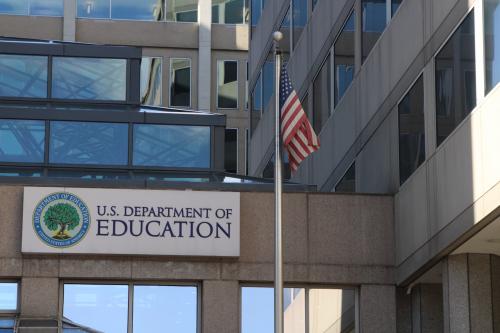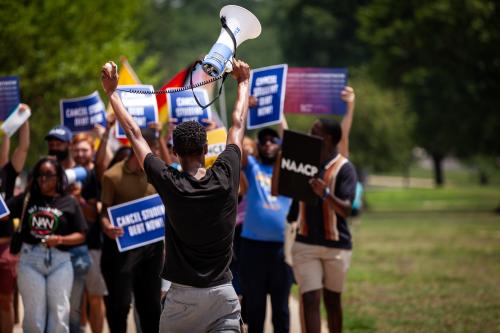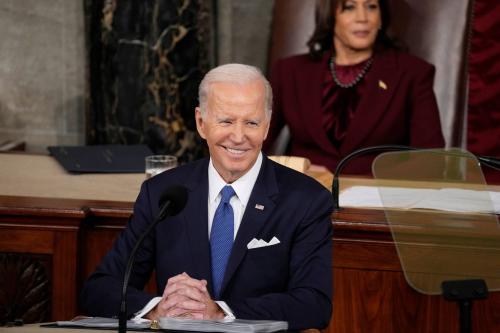Since President Biden’s inauguration, the education policy community has anticipated the release of updated school discipline guidance. These federal guidelines have been a hot-button issue through the last three presidential administrations. In 2014, the Obama administration issued a Dear Colleague Letter (DCL) that included detailed and practical guidance for protecting students’ civil rights against racial discrimination in school discipline. In 2018, the Trump administration rescinded the Obama DCL, leaving only a trimmed-down Q&A document in its place.
Whether the Biden administration would respond to the 2018 Trump-era changes has never been much of a question. How and when it would respond have been harder to decipher. The social and political context for school discipline guidance has evolved, shaped by events including the Black Lives Matter movement (and corresponding backlash), pandemic-related schooling disruptions, and continued school violence. Many civil rights and progressive advocacy organizations (and 23 state attorneys general) have urged the administration to reinstate and expand the Obama DCL. Many conservatives pushed back. The Biden administration, surely aware of the fraught politics of race and discipline, has never seemed eager to weigh in.
Now, 2.5 years into the Biden administration, we finally have updated discipline guidance. Kind of.
On the Friday before Memorial Day weekend, the U.S. Department of Education (ED) Office for Civil Rights (OCR) and U.S. Department of Justice (DOJ) Civil Rights Division released a joint letter as a resource to help schools “confront the issue of race discrimination in student discipline.” The document is vanishingly thin in substance. It summarizes 14 cases of racial discrimination in student discipline that ED and/or DOJ have resolved. Most of those cases are from the 2010s, with resolution letters that have been publicly available for years. Meanwhile, the letter lacks a definition of illegal discrimination, information about how the federal government will enforce civil rights law, guidance for school districts on mandated data collection, or suggested practices and policies to prevent discrimination. It reads like a series of case studies with little attempt at synthesis or interpretation.
In fact, the letter is so thin on content, with so little to say about the core issues involved, that it leaves us wondering if this will be ED/DOJ’s only formal response to Trump’s recission of the Obama DCL. The timing of the letter’s release—on the Friday before a holiday weekend—suggests the administration wouldn’t mind keeping this topic out of the headlines. And, indeed, very few publications picked up the story.
The reality, though, is that the Biden administration owes students and schools more than this. Protecting students’ civil rights is perhaps the federal government’s main responsibility in K-12 education, and discipline disparities have direct implications for racial equity. Moreover, student discipline remains one of the thorniest, most challenging issues for schools.
Background on the 2014 Dear Colleague Letter
The 2014 Obama DCL offered schools a robust set of guidelines on how to avoid racial discrimination in discipline. The letter defined what constitutes illegal discrimination under existing law, described the federal government’s role in investigating and addressing potential violations, and offered a lengthy list of recommendations for how to prevent discriminatory practices and policies.
Most of the controversy surrounding the Obama DCL stemmed from its inclusion of a broader definition of discrimination (“disparate impact”) than the narrower one that OCR had typically applied (“disparate treatment”). Disparate impact is the idea that school discipline policies that disproportionately harm students of color may constitute illegal racial discrimination even if those policies are racially neutral and applied in an evenhanded way. The move garnered sharp critiques from conservatives. When the Trump administration rescinded the Obama DCL in 2018 under the guise of preventing school shootings, it dropped any reference to disparate impact theory and defined much narrower conditions that would prompt OCR investigations.
What has changed since the Obama Dear Colleague Letter?
The last decade has been eventful with respect to research, policy, and practices in student discipline.
Let’s start with research. Debates over discipline guidance have been mired in broader debates about whether, and to what extent, racial discrimination contributes to discipline disparities. The Obama DCL was motivated partly by research suggesting that differences in student behavior could not explain large, persistent racial disparities in discipline rates. Research in this area is challenging due to the limits of using quantitative methods to detect racial discrimination. However, this research literature has grown stronger since 2014. For example, several recent studies use statewide or districtwide data to assess evidence of racial discrimination using the least controversial interpretation of discrimination in the Obama DCL (“disparate treatment,” which occurs when similarly situated students of different races receive unequal punishments for the same behaviors). Studies from Louisiana, North Carolina, California, and Arkansas all indicate that Black students tend to be punished more severely than white students for similar behaviors.
In other words, if anything, evidence of racially discriminatory student discipline is stronger now than it was in 2014.
While federal guidance was evolving in the 2010s, several states and districts adopted policies to limit schools’ reliance on suspensions and expulsions. Many also encouraged alternative approaches such as restorative justice practices or Positive Behavioral Interventions and Supports (PBIS). These changes appear to have taken root quickly. According to a nationally representative survey of public school principals, 62% of schools used restorative justice practices and 78% used PBIS during the 2021-22 school year. To date, evidence on the efficacy of policy reforms and alternative approaches is mixed. And most research suggests that changes to policy and practice alone don’t reduce large racial disparities in discipline outcomes.
Most recently, concerns over worsening student behavior and school violence have prompted renewed debate over whether discipline reform efforts have gone too far. Some argue that limits on suspensions hamper principals’ and teachers’ ability to create orderly classrooms, and that alternative approaches are too lenient. Despite sparse evidence that stricter discipline will remedy student misbehavior and improve school safety, lawmakers in at least a half-dozen states are considering legislation to make it easier for educators to remove misbehaving students from schools.
What the Biden administration could have done—and could still do
The long-awaited guidance on student discipline proved to be anything but. The lack of clear guidance, at a time when guidance is needed, leaves educators, policymakers, students, and families in a precarious situation.
Without a clear definition of what constitutes illegal discrimination in student discipline, how do leaders know if they have a problem? How do parents know if their children might have been mistreated such that an OCR complaint is appropriate? And how can schools design and implement sensible approaches to student discipline when they don’t know what those approaches are supposed to accomplish?
Student discipline is complicated. It’s rife with gray areas, touchy subjects, conflicting goals, and gaps in research literatures. That complexity is exactly why OCR needs to speak clearly on legal issues in student discipline, not shy away from them. If the Biden administration doesn’t want to reinstate the Obama administration’s interpretation of discriminatory practices, that’s fine. But they certainly owe us their definition. If there’s one area in which the federal government has an unambiguous responsibility in K-12 education, it’s in protecting students’ civil rights.
In fact, OCR could follow its own lead in determining next steps. Last summer, OCR released guidance for avoiding discriminatory discipline of students with disabilities. That guidance was clear and detailed, with a roadmap for school leaders to ensure they administer discipline fairly and legally. With this joint letter on racial discrimination in student discipline, OCR falls far short of its own standard.
This can’t be the administration’s one and only move to address persistent racial disparities in student discipline. Educators and school leaders need clarity and resources. And students of color deserve a more forceful repudiation of discriminatory practices in schools, especially at a time when the pendulum appears to be swinging back toward tough-on-misbehavior approaches.
This guidance fails to “meet the moment.”



Commentary
The Biden administration’s updated school discipline guidelines fail to meet the moment
June 28, 2023